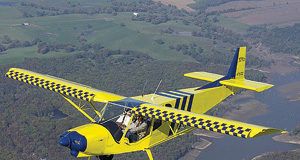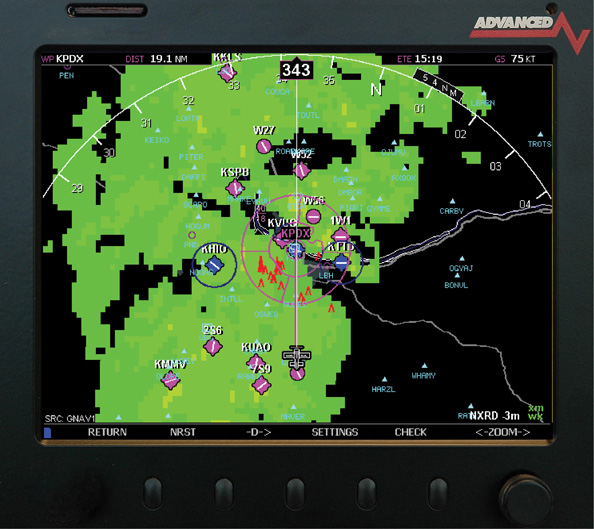
Weather depiction on the Advanced Flight Systems EFIS includes airspace and obstructions as well as navigation waypoints.
As pilots, we have an intimate relationship with weather. Sometimes its love, sometimes its hate. But as is true among humans, the more you know the easier it is. Technology has improved markedly since the days of going up for a look or getting a long-range briefing before departure and hoping that the weather picture doesn’t change too much before you get to the destination. (This issue is never will it change, just by how much.)
For builders of Experimental/Amateur-Built aircraft today, the information stream is nothing short of amazing, and it stands to get better. Technology now affords even those with the most modest budgets the capability to have a clear and fairly accurate picture of the weather situation around them and along their intended route of flight. Instead of relying purely on a flight brief as many of us have done, we now have the ability to keep an eye on ever-changing weather patterns via satellites and, soon, other means.
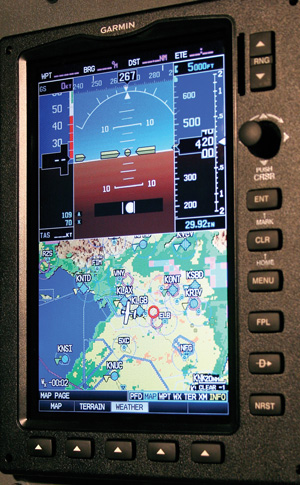
Garmins G3X EFIS includes many of the functional elements of the GPSMAP 696, including XM-transmitted weather.
Pilots and homebuilders have two primary weather information sources, which well divide as on board and datalink. On-board equipment can be an old-fashioned radar system or a sferics device (shorthand for atmospherics, which implies a passive lightning-detection device such as a Stormscope or a Strikefinder). In this sense, the on-board systems are self contained; they see the weather and relay the information to the pilot. As you’ll see in Larry Anglisanos sidebar, used sferics are a difficult sell in todays market. Many of the cheap ones are outdated or may need expensive parts. Radar just hasnt been, well, on builders radar at all-it costs too much, is difficult to install and is generally ill-suited to most homebuilts.
Strip away the on-board options and you’re left with datalink. Today, we have two main decisions to make: Do we go with the existing system, based on weather transmitted by a satellite in the XM Radio, or do we wait a bit on ADS-B? ADS-B stands for Automatic Dependent Surveillance-Broadcast. Go re-read Amy Labodas story in last months issue of KITPLANES for a primer on the system, but for todays purchase decisions its not much of a player. Yes, Garmin did just introduce the GTS 800 traffic system that has ADS-B In ports, but that box sells for nearly $10,000 and must be mated to specific Garmin displays. For the average homebuilder, its not there yet.
Closer to there is the NavWorx (www.navworx.com) ADS-B data system. This setup, available with RS-232 serial outputs and ARINC 429 outputs for about $1500, brings in ADS-B traffic information to be presented in a variety of displays. In essence, the NavWorx box emulates the Garmin GTX 330 transponders traffic-out data stream, and thats how the remote boxes, either a portable or built-in EFIS, are expected to display the data. In keeping with my Can I have a box today? philosophy, I would rate this product as being close to ready, but don’t plan one for your system if you’re aiming to fly soon. For those of you in the early planning stage of your airframe build process, keep an eye on NavWorx, and design your physical layout with room for a remote processor and stub out data feed lines to simplify retrofitting whatever ADS-B boxes come along.
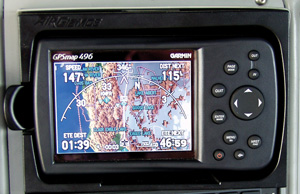
Popular with homebuilders, the Garmin 396/496 portable in an AirGizmos mount. There’s a lot of capability for a little money.
Satellites of Love
Orbiting miles above our heads, both XM and Sirius satellites are providing services to consumers that were not even dreamed of a couple decades ago. Both companies sort of merged in 2007, but the technologies between the two are still different, meaning some products will use XM satellites, which require XM-specific receivers, and some will use Sirius (the aviation weather portion marketed through WSI), which also use WSI-specific receivers.
Both companies now provide a full range of satellite-based weather services for various products, while the ADS-B weather is still in the beta-test stage and does not have the full range of features. (Supposedly, beyond the cost of the processors, it will be free.)
Several companies produce receivers for XM, most prominently Garmin (www.garmin.com), which includes a built-in XM receiver with many of its portable/handheld GPS units and also provides a stand-alone dedicated XM receiver for interface to its other product lines. All of the portable units include both aviation satellite weather as well as XM satellite music. The stand-alone GDL-69(A) is available with or without music and can be interfaced with most Garmin-compatible, panel-mount GPSes and EFISes. The new Garmin G3X EFIS is also available with or without a built-in XM weather receiver.
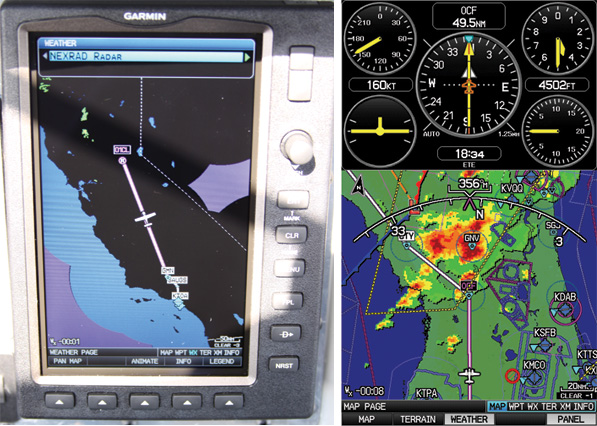
The Garmin GPSMAP 696 can be hard-mounted to the panel or carried on your lap (we like the semi-permanent mounting) and provides a large-screen depiction of the weather along with a GPS-synthesized flight panel.
The most prevalent supplier of XM weather services for most of our EFISes and portable devices is Weather Worx (WxWorx). Its components are marketed by a number of popular aviation manufacturers. Looking first at EFISes, the two most popular midrange manufacturers to incorporate XmWorx options into their systems are Advanced Flight Systems (www.advanced-flight-systems.com) and Grand Rapids Technologies (www.grtavionics.com). Both offer the systems as an add-on to their EFISes for between $550 to $950. Installation is simple, requiring minimal wiring and only a single XM antenna to be installed. We assume that Dynon Avionics (www.dynonavionics.com) will also offer XM Weather on its new SkyView units, but that feature has not yet been announced. Likewise, it seems reasonable to assume that at some point MGL Avionics (www.mglavionics.com) will add weather support to its growing line of EFISes.
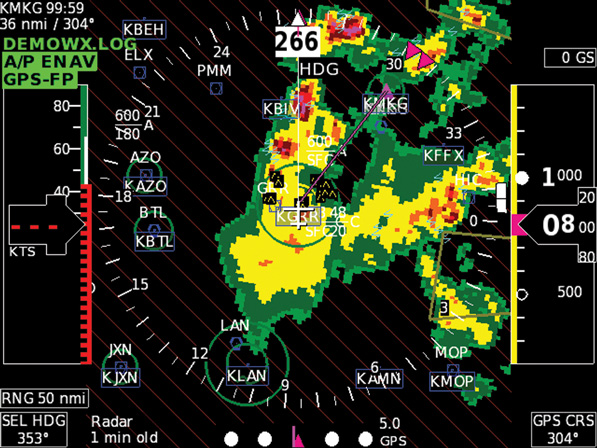
Grand Rapids Technologies EFIS devices can show weather using the WxWorx external box. Heres a nasty set of storms shown on the moving map. Red hash marks indicate an AIRMET for the area.
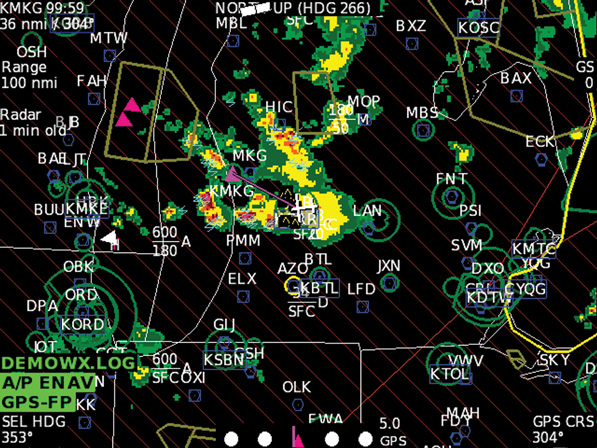
GRTs weather depiction can be combined with navaids and airspace.
Something to consider when deciding on portable- versus EFIS-based weather: Weather works best when you have a dual-screen system with either the Advanced Flight or Grand Rapids setups. To get sufficient resolution, you want a full single screen available. This applies to the Garmin G3X as well. I know there are some panel layouts and aircraft that wont take two full-size screens, or there are builders who don’t want to spend that much money, and in that instance, Id recommend an external portable solution for weather.
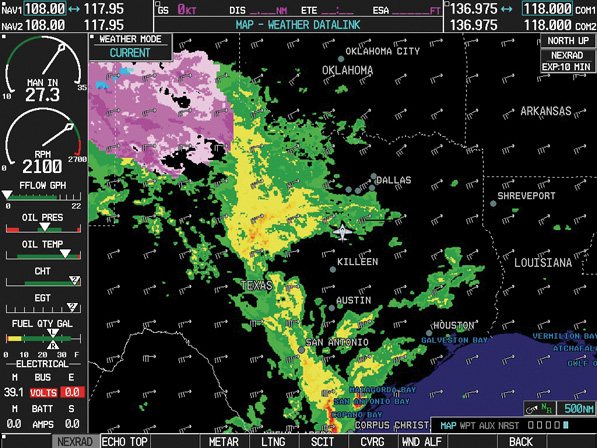
By the time you get to sophisticated systems like the Garmin G1000/G900X, there’s screen real estate to show detailed weather, such as radar and winds aloft, on the same page.
Take It with You
Aside from EFISes, another option growing in popularity is portable multifunction displays (MFDs) or electronic flight books (EFBs). These are systems that range from small PDA-type devices to full-blown laptop computers or tablets that offer everything from moving maps, charts, approach plates, flight planning, weather, airport diagrams and more. There are many dozens of manufacturers, but the most popular to date that offer the WxWorx option are Anywhere Map, Approach Systems, FlightPrep, Hangar B-17, NavAir, PC Avionics/Mountainscope, RMS/Flitesoft, Seattle Avionis/Voyager, Teletype, TruFlight and WxWorx itself.
We don’t have enough space to review the individual products, but each will provide the same weather options from the same service on a variety of displays. AvMap (www.avmap.us) and TruFlight (www.aviationsafety.com) also offer dedicated GPS units with XM interfaces. Many of the products are beginning to blur the lines between portable GPSes and full-fledged EFBs, so its difficult to classify them as one or the other, but just the same, they all offer the ability to have weather displayed in the cockpit. (When we recover from the holidays, well take a closer look at this segment of the market.)
Simplicity of installation and multifunctionality (can I say that?) are two reasons the Garmin and Bendix/King portable navigators seem to be the most popular. Starting with the GPSMAP 396 and continuing through the 496 and 696, into the G3X and now appearing in the aera portables (which are replacing all but the 696 in the x96 lineup), Garmin has provided a wide range of portables that present weather extremely well given their relatively small screen size. Bendix/King is into the category with the AV8OR and now the larger AV8OR Ace (www.bendixking/AV8OR).
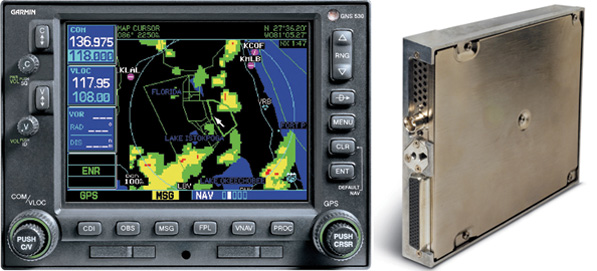
Portable weather devices have largely supplanted the certified hardwire options like Garmins GDL 69 XM datalink box, which shows weather on MFDs and Garmins own 400/500 series mapcoms.
WSI: The Other Guys
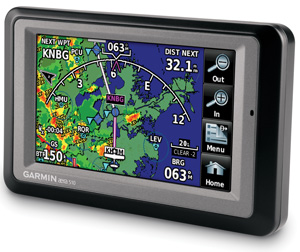
Next gen, we have the new Garmin aera, which will replace the 396 and 496 portable XM-shod GPSes.
WSI (www.wsi.com) also manufactures aviation weather satellite receivers for a number of systems. Its systems work with Chelton, Avidyne, some Garmin MFDs and panel-mount products, L3, Sandel, Universal Avionics and a number of the same EFBs mentioned earlier. WSI displays many of the same weather products and services as XM at approximately the same price. Frankly, because of Garmin and the big push with the portables, XM is probably the most popular platform.
In-cockpit satellite weather is a topic that is still hotly debated. On one side is the argument that pilots will take risks that they otherwise wouldn’t if they have this information available to them. On the other side are people like me who believe that the benefits of having this information will enable pilots to make safe and educated decisions about their flights. History is littered with many accidents that were preventable VFR flight into IMC.
Perhaps a number of those accidents wouldn’t have happened if the pilots had access to weather information. Even IFR pilots can benefit. If one has a good view of the weather in front of and behind, perhaps one wont be tempted to dip a toe in to see how bad it is before making a decision. Im of the opinion that additional information in the cockpit is a good thing. Traffic systems and weather systems are not toys, they’re valuable. But don’t just believe me. The market has already responded. Weather is fine; don’t you wish you were here?










